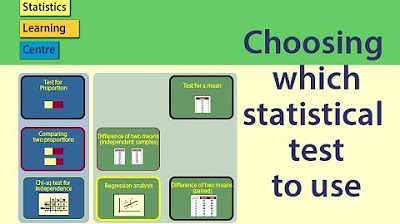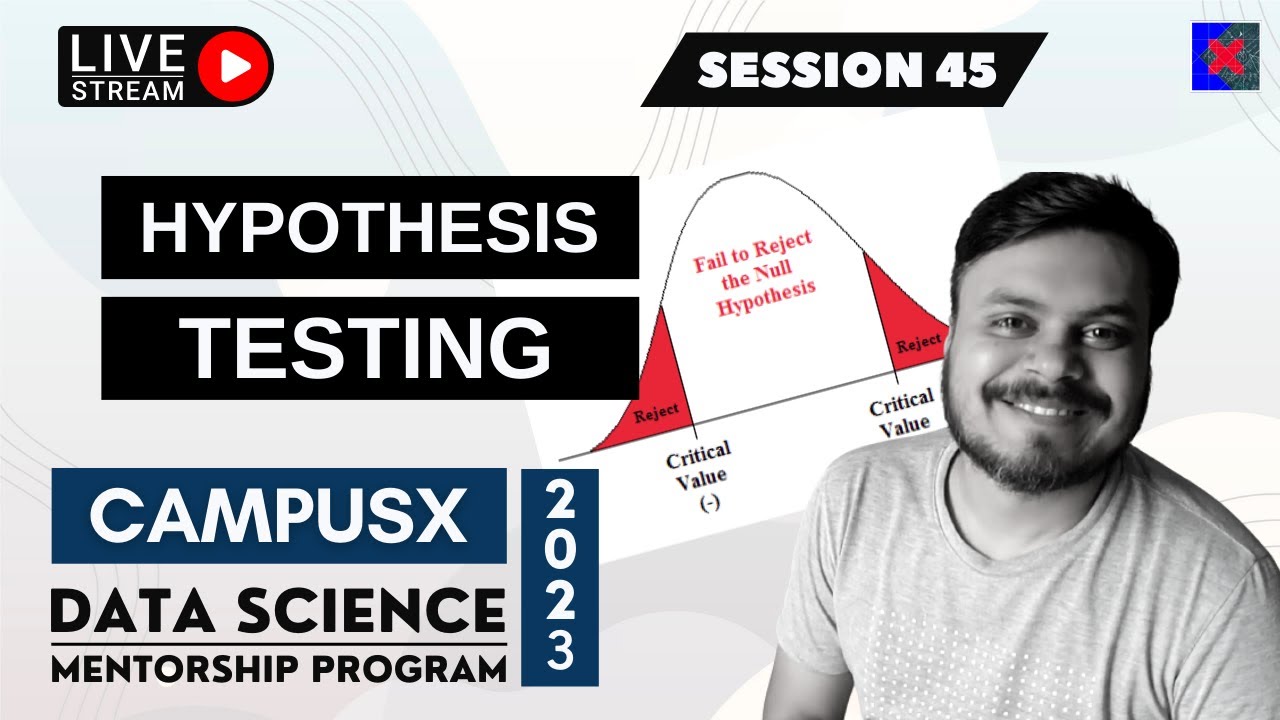A/B Testing in Data Science Interviews by a Google Data Scientist | DataInterview
TLDRThis video script offers a comprehensive guide to AB testing, a crucial concept for data science interviews at companies like Google and Uber. Host Dan, a former Google and PayPal data scientist, walks viewers through a real-life AB test case, outlining the seven essential steps, from understanding the problem to making a launch decision. He emphasizes the importance of defining success metrics, conducting validity checks, and considering business context alongside statistical results to determine whether to implement changes.
Takeaways
- 📝 AB testing is crucial for data science interviews at companies like Google, Meta, and Uber as it helps determine the impact of changes on platforms.
- 🔍 The first step in AB testing is understanding the problem statement and clarifying the success metric and user journey.
- ⚠️ Defining hypotheses is essential, including setting up null and alternative hypotheses and determining parameter values like significance level and statistical power.
- 🎯 Experiment design involves deciding the randomization unit, target user type, and other considerations to ensure a fair test.
- 🔧 Running the experiment requires proper instrumentation for data collection and analysis without prematurely checking results.
- 🤔 Validity checks, such as sanity checks and bias assessments, are vital before interpreting results to ensure the experiment's integrity.
- 📊 Interpreting results involves analyzing the direction and significance of the success metric, considering P values and confidence intervals.
- 🚀 The decision to launch changes based on AB test results should consider metric trade-offs, costs, and the risk of committing a false positive.
- 📈 The success metric chosen for AB testing should be measurable, attributable, sensitive, timely, and have low variability.
- 🛠️ A/B testing is an iterative process aimed at quickly improving products, necessitating a balance between statistical significance and practical significance.
- 💡 Preparing for AB testing interviews involves understanding the core product features and user journey, which can be helpful in designing effective tests.
Q & A
What is the importance of AB testing in data science interviews?
-AB testing is a crucial concept in data science interviews because it is widely used by companies like Google, Meta, and Uber to determine if changes on their platforms are due to random chance or actual implemented changes.
Who is the presenter of the video and what are his credentials?
-The presenter is Dan, the founder of datainterview.com, a former data scientist at Google and PayPal, who provides insights on AB testing for data science interviews.
What are the seven steps involved in the AB testing procedure as outlined in the video?
-The seven steps are: 1) Understanding the problem statement, 2) Defining hypothesis testing, 3) Designing the experiment, 4) Running the experiment, 5) Conducting validity checks, 6) Interpreting the results, and 7) Making a launch decision.
Why is it important to understand the user journey when setting up an AB test?
-Understanding the user journey is important as it helps in defining the success metric, target user population, and determining at what stage the user should be considered a participant for the experiment.
What is a success metric in the context of AB testing?
-A success metric is a measurable attribute, such as revenue per day per user, that you aim to move positively to confirm that the applied change is beneficial for the platform.
What are the qualities to consider when defining a success metric for an AB test?
-The qualities to consider are measurability, attributability, sensitivity, and timeliness of the metric.
What is the significance of setting a significance level and statistical power in an AB test?
-The significance level (alpha) is the threshold for determining statistical significance, while statistical power (usually set at 80%) is the probability of detecting an effect if the alternative hypothesis is true.
Why is it recommended not to peak at the P-value during the experiment?
-Peaking at the P-value during the experiment can lead to premature conclusions and increase the chance of falsely rejecting the null hypothesis due to variability in the data.
What are some of the validity checks performed after running an AB test?
-Validity checks include ensuring instrumentation effects, external factors, selection bias, simple ratio mismatch, and novelty effect are accounted for to ensure the experiment's results are reliable.
What factors should be considered when making a decision to launch a change based on AB test results?
-Factors to consider include metric tradeoffs, the cost of launching, and the risk of committing a false positive (Type I error).
How does the video suggest dealing with different ranges of lift and confidence intervals in the context of making a launch decision?
-The video suggests considering the practical significance of the lift, the width of the confidence interval, and whether the bounds are within positive or negative territory to decide whether to launch, iterate, or scrap the idea.
Outlines
📊 AB Testing Overview and Interview Preparation
This paragraph introduces AB testing as an essential topic for data science interviews, especially for companies like Google, Meta, and Uber. AB testing is used to determine if changes to platforms are effective or due to random chance. The speaker, Dan, outlines seven steps for conducting an AB test, emphasizing the importance of understanding the problem statement, defining hypotheses, designing the experiment, running the test, performing sanity checks, interpreting results, and making a launch decision. The example of an online clothing store, Fashion Web Store, is presented to illustrate the application of AB testing in a real-life scenario.
🛍️ Defining the User Journey and Success Metric
The paragraph delves into the importance of understanding the user journey for an e-commerce store and how it influences the selection of a success metric for AB testing. It discusses the qualities a good success metric should have, such as being measurable, attributable, sensitive, and timely. The speaker provides a pro tip on preparing for AB testing interviews by outlining the user journey of a product, which aids in designing effective tests. The chosen success metric for the example is revenue per day per user, which aligns with the business goal of increasing sales through a new product recommendation algorithm.
🎲 Hypothesis Testing and Experiment Design
This section covers the process of setting up hypothesis testing with null and alternative hypotheses for the AB test. It explains the significance level, statistical power, and minimum detectable effect. The design of the experiment is discussed, including determining the randomization unit, targeting the right user population, calculating sample size, and deciding the experiment's duration. The paragraph also advises against peeking at P-values during the experiment to prevent premature conclusions.
🔍 Running the Experiment and Validity Checks
The paragraph describes the process of running the AB test using instrumentation to collect data and track results. It stresses the importance of not making decisions based on incomplete data and the necessity of conducting validity checks, such as ensuring there are no instrumentation effects, external factors, selection bias, or novelty effects that could skew the results. The speaker also mentions the use of statistical tests like the chi-square test to validate the experiment's design.
📈 Result Interpretation and Launch Decision
The final paragraph focuses on interpreting the results of the AB test, considering the direction and statistical significance of the success metric, as well as the confidence interval. It presents an example where the new ranking algorithm in the treatment group shows a statistically significant increase in revenue per user compared to the control group. The speaker discusses factors to consider when deciding whether to launch the new algorithm, including metric trade-offs, launch costs, and the risk of a false positive. Various scenarios are explored to illustrate how different results might influence the launch decision.
📧 Conclusion and Further Assistance
In the concluding paragraph, the speaker summarizes the end-to-end process of conducting an AB test and addresses AB testing interview questions. They offer resources for further learning, such as mock interviews, coaching, courses, and community access through their website, datant.tv. The speaker invites viewers to ask questions or reach out via email for additional support.
Mindmap
Keywords
💡AB Testing
💡Hypothesis Testing
💡Success Metric
💡Significance Level
💡Statistical Power
💡Randomization Unit
💡User Journey
💡Instrumentation
💡Validity Checks
💡P-Value
💡Confidence Interval
💡Launch Decision
Highlights
AB testing is essential for data science interviews, especially for companies like Google, Meta, and Uber.
AB testing helps determine if changes on platforms are due to random chance or actual implemented changes.
The presenter, Dan, a former Google and PayPal data scientist, will provide a walkthrough of an AB test using a real-life example.
There are seven key steps in the AB testing procedure: understanding the problem, defining hypothesis testing, designing the experiment, running the experiment, conducting sanity checks, interpreting results, and making a launch decision.
Understanding the problem involves clarifying the case, identifying success metrics, and understanding the user journey.
Hypothesis testing involves setting up null and alternative hypotheses and determining parameter values like significance level and statistical power.
Experiment design includes determining the randomization unit, target user type, and other considerations.
Running the experiment requires proper instrumentation for data collection and analysis.
Sanity checks are crucial to ensure the experiment's validity and avoid flawed results due to design flaws or biases.
Interpreting results involves analyzing the P-value, considering statistical significance, and understanding the business context.
The decision to launch a change should consider statistical results, business context, and practical significance.
A real-life case study of an online clothing store, Fashion Web Store, is used to illustrate the AB testing process.
The success metric for the case study is revenue per day per user, chosen for its measurability, attributability, sensitivity, and timeliness.
The significance level is set at 0.05, and the statistical power at 80%, with a practical significance of a 1% lift.
Randomization is done at the user level, targeting users who have started searching for products.
Validity checks include ensuring no instrumentation effects, external factors, selection bias, or novelty effects.
The final decision to launch the new algorithm is based on statistical significance, practical significance, and business considerations.
The video concludes with guidance on how to address AB testing interview questions and resources for further learning.
Transcripts
Browse More Related Video

Statistical Tests: Choosing which statistical test to use

A/B Testing Mistakes to Avoid in Your Data Science Interview: Tips and Tricks!

Data Collection: Method types and tools

5 Concepts in Statistics You Should Know | Data Science Interview

Ace Product/Business Case Interview Questions: A Data-driven Approach for Data Scientists

Session 45 - Hypothesis Testing Part 1 | DSMP 2023
5.0 / 5 (0 votes)
Thanks for rating: